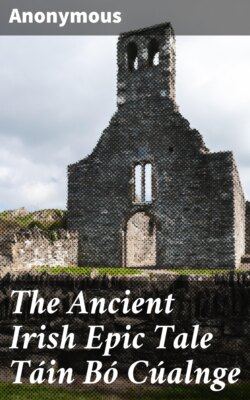Читать книгу The Ancient Irish Epic Tale Táin Bó Cúalnge - Anonymous - Страница 14
На сайте Литреса книга снята с продажи.
Оглавление"L'histoire entière de l'Irlande est une énigme si on n'a pas sans cesse à l'esprit ce fait primordial que le climat humide de l'île est tout à fait contraire à la culture des céréales, mais en revanche éminemment favorable à l'élevage du bétail, surtout de la race bovine, car le climat est encore trop humide pour l'espèce ovine." F. Lot, in La Grande Encyclopédie, xx, 956.
[2]
As it is to this day in some parts of Ireland, and as for example a female slave was sometimes appraised at three head of cattle among the ancient Gaels.
[3]
In fact the Clan Mackay was known as the Clan of the creaghs, and their perpetuation was enjoined on the rising generation from the cradle; See The Old Highlands, vol. III., p. 338, Glasgow.
[4]
Pronounced approximately Thawin' bō Hūln'ya (θα: n bo: χu: lpə).
[5]
Revue Celtique, 1895, tome xvi. pp. 405–406; Rerum Hibernicarum Scriptores, ii. 14.
[6]
Mois Conchulaind fortissimi herois Scottorum la Lugaid mac trí con, i. ri Muman, agus la Ercc, i. ri Temrach, mac Coirpri Niad fir, agus la trí maccu Calattin de Chonnachtaib; vii. mbliadna a aes intan rogab gaisced. xvii. mbliadna dano a aes intan mbói indegaid Tána Bó Cúalnge. xxvii. bliadna immorro a aes intan atbath. Revue Celtique, tome xvi. page 407.
[7]
Ridgeway.
[8]
See H. d'Arbois de Jubainville, Essai d'un catalogue de la littérature épique de l'Irlande, Paris, 1883, pages 214–216, and the Supplement to the same by G. Dottin, Revue Celtique, t. xxxiii, pages 34–35; Donald Mackinnon, A Descriptive Catalogue of Gaelic Manuscripts, Edinburgh, 1912, pp. 174, 220; E. Windisch, Táin Bó Cúalnge, Einleitung und Vorrede, S. lx. ff.
[9]
Facsimilé, page 288, foot margin.
[10]
Facsimilé, page 275, top margin.
[11]
Vd. Robert Atkinson, The Book of Leinster, Introduction, pages 7–8; J.H. Todd, Cogadh Gaedhel re Gallaibh, Rerum Britannicarum medii aevi scriptores, 1867, Introduction, pages ix and ff. Eugene O'Curry, On the Manuscript Materials of Ancient Irish History, page 186; Ernst Windisch, Táin Bó Cúalnge, pages 910–911.
[12]
Pronounced gesh or gas.
[13]
"Es gehört keine grosse Kühnheit dazu zu behaupten, dass keiner der lebenden Keltologen beispielsweise von dem wichtigsten altirischen Sagentext 'Der Rinderraub von Cualnge' … mit allen vorhandenen Hilfsmitteln ein solches fortlaufendes Verständnis des Inhalts hat, wie von einem guten Gymnasialabiturienten hinsichtlich der homerischen Gedichte ohne jegliches Hilfsmittel vor gut 30 Jahren in Deutschland verlangt wurde."—Die Kultur der Gegenwart, herausgegeben von Paul Hinneberg, Berlin, 1909. Teil I, Abt. xi, I. S. 75.
[14]
Part II, chap, lxii (Garnier Hermanos edition, page 711).
